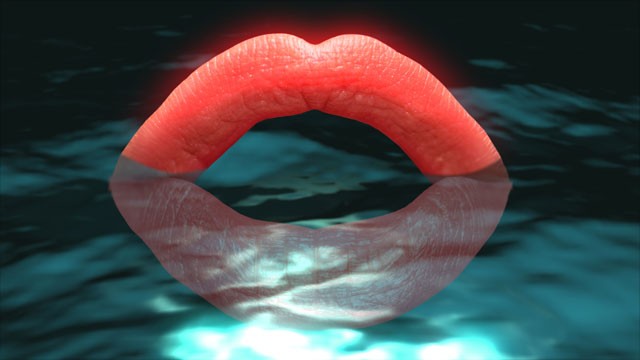In Hopscotch, Julio Cortazar’s experimental novel, the protagonist claims he’s at no risk of drowning himself a river. Although he is unravelling, the dangers he poses to himself are only metaphysical. His lover notes he’s prioritizing physical over psychic harm and scolds him, “There are also metaphysical rivers, Horacio. You’re going to jump in one of those rivers.”
This idea, that ebbs and flows of meaning have an unacknowledged power over how things manifest in the world, was thematized and tested extensively by art’s historical avant gardes. And it is taken up anew in Screen Series: Agnieszka Polska, on view at the New Museum. Inaugurating the series, the show includes five of the Berlin-based artist’s videos: I Am the Mouth II (2014), Watery Rhymes (2014), Guns (2014), The Leisure Time of the Firearm (2015), and My Little Planet (2016). Polska’s work is eerie and playfully surreal. The narrator’s voice comes through as a teacher, didactic and dryly historical, then re-emerges to addresses you like a lover. Objects spin, float, drown; lips are buoyed on CGI water; static images liquefy and bleed.
Polska’s work is at its best in My Little Planet, where science-fictive storytelling merges with its detritus. The pace is languid, the visual evidence uncanny, and the work idiosyncratic without the pressure of linearity. Text describing the restructuring of units of time sits atop video loops of subjects that assert time themselves— the cosmos, a cigarette butt leaking smoke in an ashtray, a gavel striking, a man peering into a mirror and pulling back, pleased with what he sees. The narrator explains that, in this world, time is measured by the movement of arbitrary pieces of space trash.
Polska stretches representation to its limit using surrealism and science-fiction, and in doing so, reveals the instability of the categories we use to create meaning. The original sense of a word fades away, replaced by its signifier, further replaced by the background holding it up. Words untether themselves from their referents until there is no differentiating. There is so much artificiality that it feels as if consent was never a possibility. Here, the performance of meaning in its differential intangibility leaves us to measure time by satellite trash. The new ethos coos itself into fruition until it becomes definitively bounded itself. Open-endedness: our only option.
Polska’s videos are preoccupied with the instability of language, sometimes to distraction. In My Little Planet, the work’s effectiveness comes from its text, while in Watery Rhymes and I Am the Mouth, the language is so didactic that it can foreclose other lines of thought. The show’s only non-narrative video, Guns, reflects the same problem: fixating on the unstable surface of a sign leaves little space for testing the nature of that instability.
In Guns, Polska’s animation liquefies a bright vector drawing of an eye staring down the barrel of a gun. Colors swirl outside of their geometric boundaries like a brush eddying watercolor paint. The gun’s barrel bends, eyelashes stick together, the pupil distends wetly past the eyelid. Gun and eye never move closer together within the world of the animation, but on its surface, they bleed into each other. In melting an image of violence into flows of color, Polska tries to show us that recontextualization can divorce a sign from its signifier. The gun and eye move in and out of equilibrium, melting and solidifying and melting again, and with each repetition, they look less like themselves. Polska’s successful performance of this trick does nothing to change the fact that a gun is still a gun. Unlike My Little Planet, Guns focuses too heavily on this act of dissociation to allow the contingency of objecthood and the contingency of meaning to be in cahoots with each other.
The works’ text remains the highlight. Language is less burdened by perspicacity, lifted of the pressures an affective artwork is consumed by— unless that language is participating in its own dissemination, taking on a newfangled face of motion graphics and all-too-clever transitions. One poetic verse spells out that “there is no legitimate way to measure time.” Polska is right to say so, that trying to enclose time within language is a fool’s errand. The question remains: how possible is it to liberate the properties of meaning from the physicality of language? In I Am the Mouth, a voice that presupposes to be the mouth is still a voice, as well as a mouth, as well as our narrator. Three conflate into one, into unboundedness and back again. Characterized by an economy of ideas and a failure of language, mouths have little room for objectivity, making way instead for goo that gets progressively gooier, like archives that outpace their contribution. The tenets of art’s avant-garde(s)— historically concerned with boundary-breaking over boundary-making— hold up even still. But so do its failures, and an exit from the relativism of naming remains unclaimed. The difference is in delivery.
